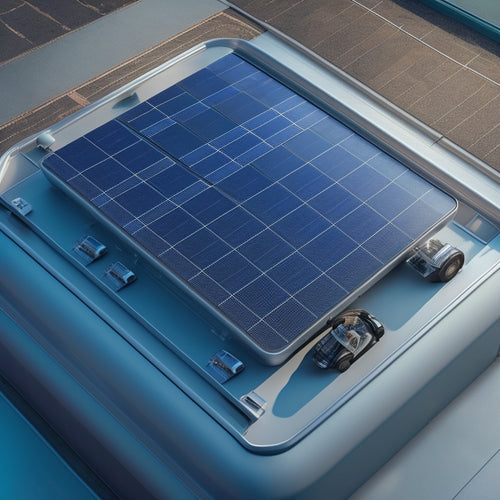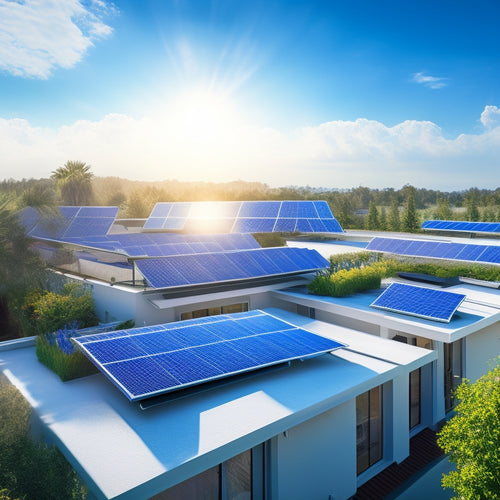
How to Calculate the Cost of a Solar Power System
Share
You'll need to calculate the cost of a solar power system by considering five key factors: system size requirements, component costs, installation and labor costs, incentives and rebates, and ongoing maintenance costs. First, determine your daily energy needs by calculating watt-hours consumed per day from past electricity bills and appliance wattage ratings. Next, calculate component costs, including solar panels, inverters, and mounting systems. Then, assess installation and labor costs, factoring in site complexity and local building codes. Don't forget to incorporate incentives, rebates, and ongoing maintenance costs into your overall calculation. Now, plunge deeper into each factor to get an accurate estimate of your solar power system's cost.
Key Takeaways
- Determine total daily energy usage in watt-hours (Wh) by calculating the sum of wattage multiplied by usage hours for all devices.
- Calculate system component costs by considering solar panels, inverters, and mounting systems, balancing cost with quality and efficiency.
- Assess installation and labor costs by evaluating site complexity, local building codes, and permits, and gathering multiple installer quotes.
- Factor in incentives and rebates, including federal tax credits, state incentives, and local rebates or discounts, to reduce upfront costs.
- Evaluate ongoing maintenance costs, including regular maintenance frequency, component replacement, and budgeting for optimal system operation and efficiency.
Determining System Size Requirements
To determine the size of the solar power system you need, first calculate your total daily energy usage in watt-hours (Wh). This will give you a clear understanding of your solar energy needs. You can do this by reviewing your past electricity bills to determine your average daily power consumption.
Make a list of all your appliances, lighting, and devices, along with their respective wattage ratings. Then, estimate the number of hours each device is used daily. Multiply the wattage rating by the number of hours used to get the total watt-hours consumed per day.
Add up the total watt-hours for all devices to get your total daily energy usage. This figure will help you determine the minimum size of the solar power system required to meet your energy needs.
Consider factors like efficiency losses, battery backup, and seasonal variations in energy usage when sizing your system. Accurately calculating your daily energy usage is essential to guarantee your solar power system can provide the necessary power to meet your requirements.
Calculating System Component Costs
Your solar power system's component costs comprise a significant portion of the overall installation expense. The quality and efficiency of these components can greatly impact the system's performance and overall cost. To calculate the component costs, you'll need to take into account the following factors:
| Component | Average Cost Range | Impact on System Efficiency |
|---|---|---|
| Solar Panels | $2.50-$3.50 per watt | High |
| Inverter | $0.50-$1.50 per watt | Medium |
| Mounting and Tracking System | $1,000-$3,000 | Low |
When selecting components, it's important to balance cost with quality and efficiency. High-quality components may be more expensive upfront but can provide better performance and longer lifetimes, ultimately reducing costs in the long run. On the other hand, lower-cost components may compromise on efficiency, leading to reduced system performance and higher costs over time. By carefully evaluating these factors, you can optimize your system's component costs and achieve the best possible return on investment.
Assessing Installation and Labor Costs
Having optimized your system's component costs, you're now ready to tackle the installation and labor costs, which can add up quickly if not properly evaluated.
These costs can vary markedly depending on the complexity of the installation and the location of your site. A detailed site evaluation is essential to identify potential challenges and opportunities that may impact labor costs.
For instance, installations on rooftops or in areas with limited access may require specialized equipment and more labor hours, increasing costs. Geographical considerations, such as local building codes and permits, must also be factored into your calculation.
You'll need to research and account for any additional fees or requirements that may apply to your specific location. By accurately evaluating these installation and labor costs, you can guarantee a thorough understanding of your overall solar power system expenditure.
Be sure to gather quotes from multiple installers and carefully review their proposals to get the best possible price for your installation.
Factoring Incentives and Rebates
As you finalize your solar power system's cost calculation, don't overlook the significant role incentives and rebates play in reducing your overall expenditure.
These benefits can substantially lower your upfront costs, making solar energy a more viable option.
When factoring in incentives and rebates, consider the following:
-
Federal Tax Credits: You can claim a federal tax credit of up to 26% of your total solar power system cost.
-
State Incentives: Many states offer additional incentives, such as rebates or tax credits, to encourage renewable energy adoption.
-
Local Rebates: Check with your local government or utility company for rebates or discounts on solar power systems.
- Financing Options: Look into financing options that allow you to spread the cost of your solar power system over time, reducing your upfront expenditure.
Evaluating Ongoing Maintenance Costs
After installing your solar power system, you'll need to take into account the ongoing maintenance costs to guarantee peak performance and longevity.
Regular maintenance is vital to make sure your system operates at its maximum capacity, and it's important to factor these costs into your overall calculation.
The maintenance frequency will depend on various factors, such as the system's size, location, and type of equipment used.
On average, you can expect to perform routine maintenance tasks every 6-12 months. These tasks may include cleaning the solar panels, inspecting electrical connections, and verifying the system's performance.
In addition to routine maintenance, you may also need to take into account the cost of replacing components that have a limited lifespan, such as inverters, which typically last around 10-15 years.
Frequently Asked Questions
Can I Install a Solar Power System Myself to Save Money?
You might think you can save money by installing a solar power system yourself, but DIY installation can be risky and may void warranties, negating potential cost savings, so it's essential to weigh the pros and cons before making a decision.
How Long Does a Typical Solar Power System Last?
You can expect a typical solar power system to last around 25-30 years, with a solar panel lifespan of 30-40 years, depending on maintenance requirements, which include regular cleaning and occasional inverter replacements to guarantee peak energy output.
Are Energy Storage Systems Compatible With Solar Power?
A million times yes, you can achieve energy independence with energy storage systems seamlessly compatible with solar power, amplifying environmental benefits and enabling you to utilize the sun's energy whenever you need it, on your terms.
Can I Add More Panels to My System Later On?
You can future-proof your solar setup by ensuring panel compatibility, allowing you to add more panels later for increased energy production, and even integrate energy storage systems for maximum power output and flexibility.
Will Solar Panels Increase My Property Value?
You'll likely see an increase in property value, as solar panels often enhance your home's appeal to potential buyers, according to market trends and property appraisal experts, who factor in the system's quality and installation.
Related Posts
-

Top Solar Panels for Car Battery Maintenance
When selecting top solar panels for car battery maintenance, consider high-efficiency models with high wattage output...
-

Eco-Friendly Car Battery Solutions Available Online
You can now shop online for eco-friendly car battery solutions that not only reduce your carbon footprint but also of...
-

Best Solar Panel Options for Maximum Energy Savings
You can maximize your energy savings with solar panels that boast efficiency ratings above 20%, paired with extensive...


